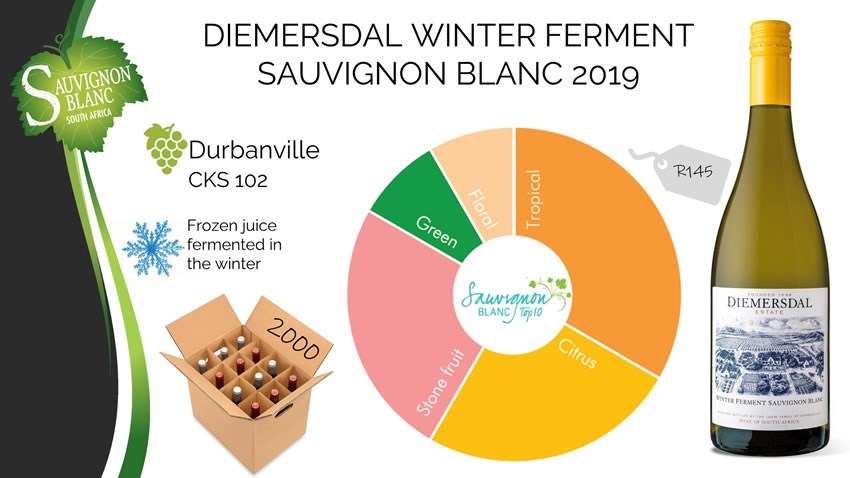South Africa has the ability to produce a myriad of Sauvignon Blanc styles as this year’s competition has shown again, from the crunchy lemon citrus to the warmly exotic, slightly oaked, wild yeast fermented and everything else in-between, including Sauvignons with a wallop of blackcurrant notes! (www.wine.co.za article ‘The Blackcurrant in your favourite Sauvignon Blanc’ 19/10/19).
Behind the winners, and every other Sauvignon Blanc, are methoxypyrazines and thiols. Methoxypyrazines (MPZ) are those compounds that produce the asparagus and herbaceous notes in Sauvignon, they are behind the green pepper and cut grass aromas. Thiols produce the more exotic fruit notes, like passion fruit and guava.
Dr Carien Coetzee, from Basic Wine, has done much research and published several articles in this area (see https://www.basicwine.co.za/copy-of-publications) and will again be presenting at the forthcoming Technical Seminar of the winners in November.
Carien recently shared some analysis with Cape Wine Academy Diploma students.
The aim was to compare South African Sauvignon Blanc with that of New Zealand, a country famed for its successful style. Both are New World countries in wine terms, and both produce world class Sauvignon in a continuum of styles. But there is a difference between the countries’ wines and among other characteristics are the concentration of methoxypyrazines and thiols, their production, enhancement and retention.
To begin, Carien showed the aromatic analysis of the winning wines in the Sauvignon Blanc South Africa Top 10 competition from 2015 to 2018. Carien has spent many years chemically analysing the winning wines for Sauvignon Blanc South Africa and results show that no single style tends to dominate the competition, though the tropical (thiol rich) style just outweighs the MPZ style and together they form nearly two thirds of the myriad variations. It also shows that wineries do not produce the same chemical characteristics each year in their wines.

The 2019 Sauvignon Blanc South Africa Top 10 winners showed that some wines had much higher and dominant levels of tropical fruit notes whilst one was dominated by citrus and mineral flint without evidence of tropical fruits. Similarly others had much greater pyrazine dominance and very little thiol nuance – especially from cooler regions, though by far the majority of all wines reflected tropical fruit notes to a degree. Carien’s analysis shows that Top 10 winners consistently show more than one or two elements, with the 2019’s listing ‘mineral, floral, citrus, wooded, confectionary and stone fruit’ in varying amounts as part of their make-up.
Interestingly, cooler regions such as Cape Agulhus and Durbanville often had higher readings of thiols than green fruits and comparatively milder areas such as Stellenbosch and Breedekloof still showed the presence of green pyrazines.
So what effects the amount of pyrazines in Sauvignon? Sun exposure seems to lower the amounts, research has shown that exposure before veraison (the colour change ripening cue) limits the amount made and after veraison the amounts that degrade. Canopy management, such as leaf removal and irrigation before ripening will have a greater reduction of pyrazines. Too much irrigation, though, can produce larger canopies and more growth which might mean more pyrazines even in a warm climate. Lowering yields perhaps strangely, has been found to hugely increase the amount of pyrazines present (gravitywinehouse.com).
When pyrazine levels are very high wines don’t tend to age well, especially with inadequate storage conditions, and as Dr Coetzee says, “they can be quite unpleasant, with strongly vegetal notes”. In the winery, pre-ferment clarification and juice settling can also reduce pyrazines, and particular yeast strains can produce other flavours to balance out the green nuances or mask it.
One of the pathways in which thiols, also organic compounds, are formed is through precursors in the berry, which increase during ripening (just as methoxypyrazines decrease) which then are formed during fermentation. Their intensity, therefore, is also subject to canopy management, sunshine hours, harvest times and winemaking techniques. Those passion fruit, guava and grapefruit notes are easily degraded and lost, though. Storing the wine at low temperatures might help delay this degradation and preserve the thiols for longer.
Comparisons of the Sauvignon Blanc winners over a four year period showed wines with more tropical notes than green notes on the whole, also that New Zealand wines had a much higher concentration of tropical compounds than those selected SA Sauvignons.
Thiol (3MH) numbers rarely exceeded 1000ng/l in the Top 10 SA Sauvignons, with one or two exceptions, but in Marlborough (NZ) they can easily achieve up to 6,500ng/l, ‘values not normally seen in SA Sauvignon’, says Carien.
A second volatile thiol (3MHA), showed many wines around 100ng/l, with three exceptions going above 500ng/l yet around 850ng/l and higher could be attained in New Zealand Sauvignon. A third volatile thiol, 4MMP, responsible for the blackcurrant and even ‘cat pee’ notes was more uneven in SA Sauvignon winners, some showed very high readings rarely seen in other countries, even unusual in New Zealand, others had less than was found in NZ Sauvignons.
These higher thiol and pyrazine levels supports the hugely expressive nature of New Zealand Sauvignon, its remarkable pungency, its concentration of pure fruity flavours, its genuine attractiveness. Yet, with seven regions represented by winning 2020 Sauvignon Blanc South Africa Top 10 producers, and grapes sourced from varying climates, it also shows the somewhat wider range of styles available to South African winemakers, the ability to recognise and reflect terroir, to produce world class wines and to offer different aromas and flavours, guaranteeing something for everyone.

www.basicwine.co.za
www.sauvignonblanc.com
www.capewineacademy.co.za